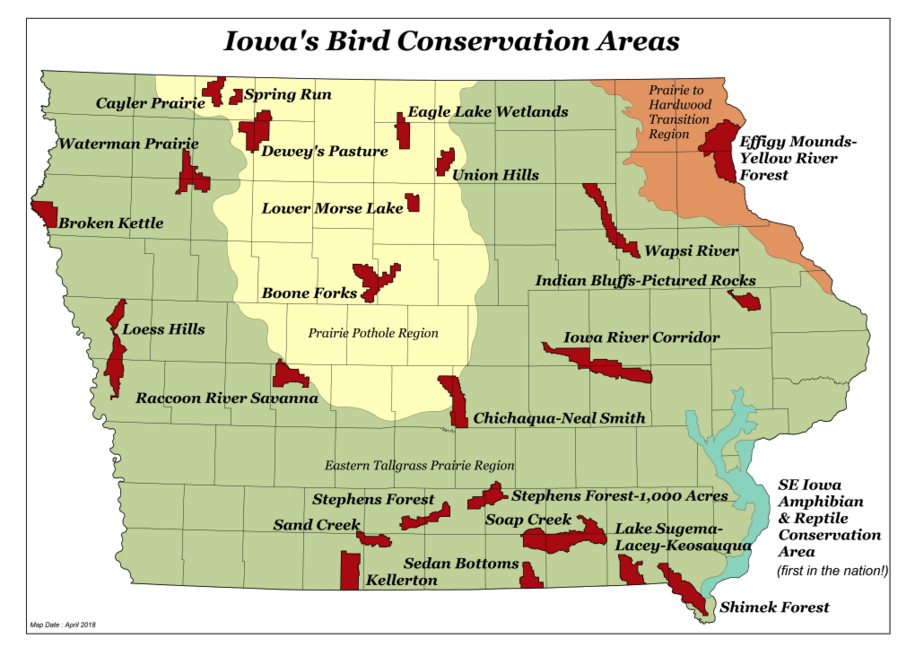On this page...
Iowa Bird Conservation Areas Program
Within the last two decades, alarming declines in a large number of species of North American birds have led to the emergence of national and international initiatives dedicated to conservation of game and nongame birds.
Various conservation programs or plans aimed at individual groups of declining birds are gathering under the umbrella of North American Bird Conservation Initiative (NABCI) to conserve "all birds in all habitats."
As part of this initiative and in an effort to protect dwindling populations of many Iowa birds, Iowa's Bird Conservation Area (BCA) Program was established by the DNR Wildlife Bureau in 2001.
Back to topWhat is a BCA?
The Bird Conservation Area (BCA) concept was first proposed by the Midwest Working Group of Partners In Flight (PIF) to maintain populations of breeding grassland birds. That has since been expanded to include birds breeding in a variety of habitats, including grassland, wetland, woodland, and savanna. This concept is backed by research that suggests viable bird populations require conservation efforts at a landscape-scale. The first BCA, the Kellerton Grasslands Bird Conservation Area, was established in Ringgold County in 2001.
Iowa DNR has designated 24 BCAs across the state in partnership with local conservation agencies and groups. Iowa BCAs encompass at least 10,000 acres of public and/or private lands that includes approximately 30% of the area as key bird habitat. For instance, in a designated grassland BCA, at least 25-30% of the total land cover should be some type of grassland.
Each BCA also includes a large "core" area of protected high-quality habitat (typically at least 20% of the area), with a minimum 2,000 acre core area targeted. Around this core are private lands, plus additional public tracts, managed for good bird habitat or at least maintained to be "neutral" in how they affect bird life.
Many of these outlying parcels are 100 acres or more of contiguous targeted habitat to complete a "matrix" of quality habitat for specific priority birds. (see the Iowa BCA Guidance Document for details of history, current status, and future direction of this BCA Program). BCAs are a conservation designation and a way to prioritize habitat for Iowa birds. No legal requirements are imposed on the private lands within BCA boundaries.
Back to topValue of BCAs
Habitat loss and fragmentation is one factor contributing to the decline of many bird species. By establishing BCAs with areas of core habitat for birds, and prioritizing bird conservation and habitat management in these regions, we can help to stabilize bird populations across Iowa and provide opportunities for Iowans to enjoy the bird diversity in our state.
Bird watching, or birding, is one of North America's fastest growing pastimes, with an estimated 96 million participants in the United States. These and other associated activities benefit the economies of those regions where they occur.
For example, a recent survey by U.S. Fish & Wildlife Service found that well over one million Iowans watch wildlife each year, and Iowa residents and nonresidents spend at least $400 million on wildlife watching in Iowa each year. Wildlife watching expenditures have grown in the U.S. by over 50% since 1991.
Bird Conservation Areas draw the attention of eco-tourism to Iowa, with economic gain for the area motels, restaurants, and other businesses in the BCA vicinity. For example, Lucas County, which contains portions of two Stephens Forest BCA’s, sponsored a “Big Day of Birding” in May 2016 and a “Birding Festival."

Iowa BCA Brochures (coming soon)
- Soap Creek, Stephens Forest
- Kellerton Grasslands
- Spring Run Grasslands
- Broken Kettle Grasslands
- Effigy Mounds-Yellow River Forest
- Iowa River Corridor
- Dewey's Pasture
- Wapsi River
- Eagle Lake Wetlands
- Stephens Forest
- Lower Morse Lake Grasslands
- Sand Creek Woodland Savanna
- Boone Forks Woodland
- Cayler Prairie
- Union Hills
- Chichaqua-Neal Smith
- Shimek Forest
- Raccoon River
- Sedan Bottoms
- Thousand Acres
- Waterman Prairie
- Lake Sugema-Lacey-Keo
- Indian BluffsLoess Hills
- Loess Hills